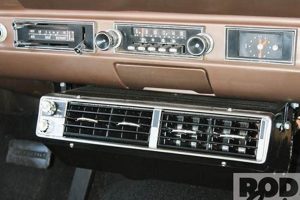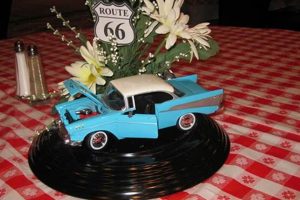The availability of classic Ford automobiles presents a unique opportunity for collectors, enthusiasts, and those seeking a tangible connection to automotive history. These vehicles, often restored or meticulously maintained, represent a bygone era of design and engineering, offering a glimpse into the automotive landscape of the past.
Acquiring an older Ford model offers numerous advantages. It allows individuals to own a piece of American heritage, appreciating the craftsmanship and innovation that defined early automotive production. Such vehicles can also appreciate in value over time, offering a potential investment opportunity. Furthermore, the community surrounding vintage cars provides a network of knowledgeable individuals, resources, and shared passion.
The subsequent sections will delve into the various aspects of acquiring and maintaining such an automotive treasure, including considerations for condition assessment, sourcing reliable vendors, and navigating the intricacies of restoration and preservation.
Essential Considerations for Acquiring Classic Ford Automobiles
The acquisition of a vintage Ford requires careful consideration to ensure a satisfactory and informed purchase. Due diligence and thorough research are paramount.
Tip 1: Research Specific Models: Prior to purchase, conduct thorough research on the desired model. Understand its production years, common mechanical issues, and variations in features and specifications. This will facilitate a more informed assessment during inspection.
Tip 2: Inspect Vehicle History: Obtain the vehicle identification number (VIN) and conduct a comprehensive vehicle history report. This report can reveal information about previous owners, accidents, title issues, and odometer discrepancies, providing valuable insights into the vehicle’s past.
Tip 3: Evaluate Condition Critically: Conduct a meticulous inspection of the vehicle’s condition, both cosmetically and mechanically. Assess the body for rust, damage, and evidence of prior repairs. Examine the engine, transmission, and other mechanical components for signs of wear, leaks, or malfunctions. If possible, engage a qualified mechanic specializing in classic automobiles to perform a pre-purchase inspection.
Tip 4: Verify Authenticity: Confirm the vehicle’s authenticity by verifying its original components and features. Consult with experts and reference original documentation to ensure that the vehicle has not been significantly altered or misrepresented. Be wary of “restomods” if originality is a primary concern.
Tip 5: Assess Documentation: Scrutinize all available documentation, including the title, registration, service records, and any historical paperwork. Verify that the title is clear and free of any liens or encumbrances. Review service records to assess the vehicle’s maintenance history and identify any potential issues.
Tip 6: Consider Storage: Understand storage requirements before acquiring. Exposure to the elements can rapidly deteriorate the condition of classic cars. Secure, climate controlled environment is highly recommended.
Tip 7: Negotiate Strategically: Research the market value of comparable vehicles to establish a reasonable price range. Be prepared to negotiate based on the vehicle’s condition, authenticity, and documentation. Obtain multiple appraisals, if necessary, to support a fair offer.
These considerations are crucial for making an informed decision and mitigating potential risks. Prospective buyers should approach the process with diligence and a commitment to thorough investigation.
The following sections will address the restoration, valuation and maintenance aspects.
1. Model Authenticity
Model authenticity directly influences the valuation and desirability within the market for these classic Ford automobiles. A genuine, unaltered example of a sought-after model commands a premium compared to replicas or extensively modified vehicles. This stems from the historical significance and inherent value associated with preserving original design and manufacturing specifications. Discrepancies between the vehicle’s current state and its original configuration can diminish its collectability and, consequently, its market value. For instance, a purported 1969 Boss 429 Mustang must exhibit the correct engine code, body panels, and interior trim to be considered authentic; deviations significantly impact its perceived value.
The process of verifying model authenticity often involves meticulous examination of factory markings, component part numbers, and original documentation. Experts utilize resources such as build sheets, factory service manuals, and historical databases to confirm a vehicle’s lineage and specifications. The presence of non-original parts or modifications, while potentially improving performance or aesthetics, can detract from the vehicle’s authenticity and appeal to purists and collectors. The Society of Automotive Historians and specialized marque clubs play crucial roles in disseminating accurate information and assisting in the authentication process.
Ultimately, establishing model authenticity is essential for both buyers and sellers in the vintage Ford market. It ensures transparency, protects against fraud, and preserves the historical integrity of these vehicles. While modifications and customization may hold personal value, they generally diminish the vehicle’s desirability and financial worth within the broader collector car market. Prioritizing authenticity enhances the long-term value and appreciation of these historical artifacts.
2. Condition Assessment
Condition assessment is a critical component in transactions involving vintage Ford automobiles. The condition of a vehicle directly influences its market value, insurability, and the extent of necessary restoration or maintenance. A comprehensive assessment considers both the vehicle’s cosmetic and mechanical state, providing prospective buyers with a clear understanding of its overall condition and potential long-term costs. For example, a classic Mustang exhibiting significant rust damage to the body panels will require extensive repairs, impacting both the purchase price and subsequent restoration expenses. Similarly, a vintage F-100 pickup with a non-running engine necessitates a thorough mechanical inspection to determine the extent of repairs needed.
The assessment process typically involves a detailed visual inspection, mechanical testing, and review of available documentation. Visual inspection focuses on identifying rust, body damage, paint imperfections, and interior wear. Mechanical testing assesses the engine’s performance, transmission functionality, brake system effectiveness, and suspension integrity. Documentation, such as maintenance records and repair invoices, provides valuable insights into the vehicle’s past care and potential problem areas. Professional appraisers and mechanics specializing in classic cars can conduct thorough condition assessments, providing unbiased evaluations and cost estimates for necessary repairs or restoration. The results of the assessment influence the negotiation process, ensuring that the purchase price reflects the vehicle’s true condition and potential liabilities.
In conclusion, the quality of the condition assessment informs purchase decisions within the classic Ford automobile market. It mitigates risks by uncovering hidden issues, empowering buyers and sellers to negotiate fairly. Prioritizing comprehensive condition assessment ensures transparency and protects both parties in the exchange.
3. Market Valuation
Market valuation is an essential determinant in the trade of vintage Ford automobiles. It establishes a benchmark for pricing, reflecting the interplay of supply and demand, historical significance, and vehicle condition. Accurate valuation ensures fairness in transactions and protects both buyers and sellers from financial miscalculations. For example, the assessed market value of a 1965 Ford Mustang convertible in pristine condition will substantially exceed that of a similar model exhibiting significant rust or mechanical issues. The discrepancy reflects the cost associated with restoration and the desirability of well-preserved examples.
Several factors influence the market valuation of vintage Ford automobiles. These include model rarity, originality, historical significance, provenance, and condition. Vehicles with documented racing history or celebrity ownership command premium prices. The presence of original components, unrestored condition, and meticulous maintenance records further enhance value. Published price guides, auction results, and sales data from specialized dealerships provide benchmarks for assessing market value. Professional appraisers, possessing expertise in classic automobiles, can conduct comprehensive valuations considering all relevant factors. Such evaluations are often necessary for insurance purposes, estate planning, or resolving disputes between buyers and sellers. Failure to accurately assess market value can result in financial losses for either party, highlighting the importance of informed decision-making.
In summary, market valuation provides a framework for determining the fair price of vintage Ford automobiles. It encompasses various factors, ensuring transparent transactions and protecting financial interests. Accurate valuation requires careful research, expert consultation, and a thorough understanding of market dynamics. By prioritizing informed valuation practices, both buyers and sellers can navigate the classic car market with confidence.
4. Restoration Quality
The quality of restoration directly and significantly impacts the value and marketability of vintage Ford automobiles. A high-quality restoration enhances the vehicle’s historical accuracy, aesthetic appeal, and mechanical reliability, thereby increasing its desirability among collectors and enthusiasts. Conversely, a poorly executed restoration can diminish the vehicle’s value and render it less appealing to potential buyers. For example, a meticulously restored 1967 Shelby GT500, featuring correct finishes, original parts, and expertly rebuilt mechanical components, will command a substantially higher price than a similar vehicle with a substandard restoration characterized by incorrect parts, poor workmanship, and compromised mechanical functionality.
The restoration process for vintage Ford automobiles involves several key stages, each requiring specialized skills and attention to detail. These stages include bodywork and paint, mechanical component rebuilding, interior refurbishment, and trim restoration. High-quality restorations prioritize the use of original or reproduction parts that adhere to factory specifications. Expert technicians employ correct techniques and finishes to ensure historical accuracy. The level of detail and precision exhibited throughout the restoration process directly impacts the vehicle’s overall quality and perceived value. Consider the restoration of a 1932 Ford Deuce Coupe; accurate reproduction of the original paint color, meticulous attention to interior fabric and trim, and expert rebuilding of the Flathead V8 engine are crucial for maximizing its value and authenticity.
In conclusion, restoration quality is an inseparable aspect of the vintage Ford automobile market. It influences value, marketability, and the long-term preservation of automotive history. Vehicles with high-quality restorations command premium prices and appeal to discerning collectors, while those with substandard restorations suffer diminished value and limited market appeal. Therefore, owners considering restoration should prioritize quality workmanship and historical accuracy to maximize the value and desirability of their vintage Ford automobiles.
5. Documentation Completeness
The comprehensiveness of documentation significantly impacts the valuation and marketability of classic Ford automobiles. Complete and accurate records provide a verifiable history, substantiating authenticity and confirming provenance. The presence of original build sheets, sales invoices, service records, and ownership history establishes a clear chain of custody, increasing buyer confidence and commanding a premium in the market. Conversely, incomplete or missing documentation creates uncertainty and can detract from the vehicle’s value. The absence of essential records may lead to skepticism regarding the vehicle’s originality, condition, and past maintenance, potentially deterring prospective purchasers.
The types of documentation considered valuable vary depending on the specific model and its historical significance. For example, in the case of a Shelby Mustang, original factory invoices, window stickers, and Shelby Automotive paperwork are crucial for verifying its authenticity and documenting its unique features. Similarly, for a vintage Ford truck, original sales brochures, dealer correspondence, and documented service history enhance its value and appeal to collectors. Complete documentation mitigates the risk of fraud or misrepresentation, providing buyers with assurance regarding the vehicle’s true identity and history. It also facilitates future restoration efforts by providing valuable insights into the vehicle’s original specifications and components.
In conclusion, the completeness of documentation forms a critical component of the value proposition for vintage Ford automobiles. It fosters trust, enhances transparency, and safeguards against potential risks. Prioritizing documentation completeness is essential for both buyers and sellers, ensuring a fair and informed transaction. The presence or absence of key records can significantly influence the perceived value and marketability of these classic vehicles, underscoring the importance of meticulous record-keeping and thorough verification.
6. Vendor Reputation
Vendor reputation constitutes a critical element in the “vintage ford cars for sale” market. The historical complexity and potential for misrepresentation inherent in vintage vehicles make vendor trustworthiness paramount. A reputable vendor establishes confidence by providing accurate vehicle descriptions, transparent transaction practices, and demonstrable expertise. Consequently, buyers are more likely to invest in vehicles offered by vendors with established positive reputations, leading to increased sales and higher market values for the vehicles they offer. Conversely, vendors with poor reputations often struggle to attract buyers, necessitating price reductions and potentially leading to business instability.
The significance of vendor reputation is exemplified by specialized dealerships that focus exclusively on vintage Ford automobiles. These dealerships often cultivate long-term relationships with collectors and enthusiasts, built on a foundation of trust and expertise. They invest in thorough vehicle inspections, comprehensive documentation, and transparent sales practices. Their reputation becomes a valuable asset, allowing them to command premium prices and maintain a consistent customer base. An alternative instance involves private sellers or smaller dealerships lacking established reputations. These vendors may encounter difficulty selling vehicles, even if the vehicles themselves are of comparable quality, due to a lack of buyer confidence. Potential buyers may be wary of undisclosed issues or inaccurate representations, leading them to seek out vendors with more credible track records.
The vendor reputation offers essential assurance and influences market dynamics. Transparent practices, ethical conduct, and demonstrable expertise correlate directly with vendor success. Conversely, negative reputation inhibits transactions, diminishes value, and ultimately compromises success in vintage Ford sales. Buyers prioritize vendor reputation as a protective measure, while vendors recognize its fundamental value in market competitiveness and growth.
7. Maintenance History
Maintenance history serves as a critical indicator of a classic Ford automobile’s condition and long-term reliability, directly impacting its valuation and marketability. A well-documented maintenance record provides tangible evidence of consistent care, revealing adherence to recommended service schedules, prompt attention to necessary repairs, and the overall diligence of previous owners. This history offers prospective buyers a valuable insight into the vehicle’s mechanical health, allowing for a more informed assessment of potential future maintenance costs and overall ownership experience. For example, a vintage Mustang with records demonstrating regular oil changes, tune-ups, and timely replacement of wear items signals a higher level of care compared to an identical vehicle lacking such documentation. This positively affects its valuation and desirability among discerning collectors.
The absence of a comprehensive maintenance history introduces significant uncertainty and risk for potential buyers. It raises concerns about potential hidden mechanical issues, neglected repairs, and the overall condition of critical components. This lack of transparency can lead to decreased buyer confidence and a corresponding reduction in the vehicle’s market value. An illustrative example involves a classic Ford truck with no maintenance records. While the truck may appear aesthetically pleasing, the absence of verifiable maintenance information raises questions about the engine’s condition, the transmission’s reliability, and the functionality of other essential systems. Prospective buyers may hesitate to invest in such a vehicle without a thorough and costly pre-purchase inspection, reflecting the tangible impact of incomplete maintenance records.
In summary, maintenance history constitutes a crucial element in the evaluation of vintage Ford automobiles. Its presence provides valuable assurance and enhances market value, while its absence introduces uncertainty and risk. Prioritizing vehicles with comprehensive maintenance records mitigates potential future costs and promotes a more informed purchasing decision, emphasizing the practical significance of this understanding within the classic car market. The correlation serves as essential information for stakeholders.
Frequently Asked Questions
The following questions address common inquiries regarding the acquisition, valuation, and ownership of classic Ford automobiles.
Question 1: What factors most significantly impact the valuation of a vintage Ford?
Several factors influence valuation, including model rarity, originality, condition (cosmetic and mechanical), provenance (ownership history), and the completeness of documentation. Highly sought-after models in excellent, original condition with verifiable histories command premium prices.
Question 2: How can potential buyers verify the authenticity of a “vintage ford cars for sale”?
Verifying authenticity involves meticulous examination of factory markings, component part numbers, and original documentation. Resources such as build sheets, factory service manuals, and historical databases can assist in confirming a vehicle’s lineage and specifications. Consulting with marque experts is also recommended.
Question 3: What are the key considerations when assessing the condition of a classic Ford?
Condition assessment entails a detailed inspection of both cosmetic and mechanical aspects. Focus on identifying rust, body damage, paint imperfections, interior wear, engine performance, transmission functionality, and brake system effectiveness. A pre-purchase inspection by a qualified mechanic specializing in vintage vehicles is highly advisable.
Question 4: Where are the most reliable sources to locate “vintage ford cars for sale”?
Reliable sources include specialized classic car dealerships, reputable online auction sites, marque-specific enthusiast clubs, and private sellers with established reputations. Exercising due diligence and verifying the seller’s credibility is crucial.
Question 5: What type of documentation is most important to review before purchasing a vintage Ford?
Essential documentation includes the vehicle title (verifying ownership and absence of liens), original sales invoices or build sheets (confirming authenticity), service records (detailing maintenance history), and ownership history (establishing provenance). Complete and accurate records significantly enhance the vehicle’s value and desirability.
Question 6: What are the typical costs associated with owning and maintaining a vintage Ford?
Ownership costs vary depending on the vehicle’s condition and usage. Expect expenses related to routine maintenance (oil changes, tune-ups), repairs (addressing mechanical issues), restoration (addressing cosmetic or structural damage), storage (climate-controlled environments), insurance (specialized coverage for classic vehicles), and potential upgrades (improving performance or safety).
These frequently asked questions aim to provide clarity and guidance for those considering the acquisition of a classic Ford automobile.
The subsequent sections will discuss resources and community aspects.
Conclusion
The exploration of the market for vintage Ford cars for sale reveals a complex landscape requiring diligent research, careful evaluation, and informed decision-making. Considerations of authenticity, condition, market valuation, restoration quality, documentation, and vendor reputation are paramount in ensuring a successful transaction. The ownership experience extends beyond the initial purchase, encompassing ongoing maintenance, preservation, and engagement with a passionate community of enthusiasts.
Acquiring a classic Ford represents more than a mere transaction; it signifies an investment in automotive history. Prospective buyers are encouraged to approach the market with prudence, seeking expert guidance and prioritizing comprehensive due diligence. Preserving these iconic vehicles safeguards a tangible link to the past, ensuring that future generations can appreciate the craftsmanship and innovation of a bygone era.







